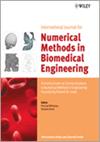V. Denoël
{"title":"半解析法分析带接触的演化结构的优点","authors":"V. Denoël","doi":"10.1002/CNM.1059","DOIUrl":null,"url":null,"abstract":"This paper presents a semi-analytical approach for the evolution analysis of a beam into given boundaries. The analytical description of contact locations, contact forces and beam deflections results in an exact modelling of the phenomenon (no penetration allowed). Despite the apparent complexity of the problem, the analytical relations leading to two-point boundary and integro-restrained differential equations are formally written. An iterative resolution of these equations is adopted by converting the problem into a single-point boundary value one. Due to a proper selection of the global unknowns, namely the contact forces and their locations, the proposed method is particularly efficient in the context of evolving structures. The resolution is illustrated on a simple example, and comparisons with the finite element method are given as persuasive arguments. Copyright © 2007 John Wiley & Sons, Ltd.","PeriodicalId":51245,"journal":{"name":"Communications in Numerical Methods in Engineering","volume":"24 1","pages":"1667-1683"},"PeriodicalIF":0.0000,"publicationDate":"2007-10-08","publicationTypes":"Journal Article","fieldsOfStudy":null,"isOpenAccess":false,"openAccessPdf":"https://sci-hub-pdf.com/10.1002/CNM.1059","citationCount":"17","resultStr":"{\"title\":\"Advantages of a semi-analytical approach for the analysis of an evolving structure with contacts\",\"authors\":\"V. Denoël\",\"doi\":\"10.1002/CNM.1059\",\"DOIUrl\":null,\"url\":null,\"abstract\":\"This paper presents a semi-analytical approach for the evolution analysis of a beam into given boundaries. The analytical description of contact locations, contact forces and beam deflections results in an exact modelling of the phenomenon (no penetration allowed). Despite the apparent complexity of the problem, the analytical relations leading to two-point boundary and integro-restrained differential equations are formally written. An iterative resolution of these equations is adopted by converting the problem into a single-point boundary value one. Due to a proper selection of the global unknowns, namely the contact forces and their locations, the proposed method is particularly efficient in the context of evolving structures. The resolution is illustrated on a simple example, and comparisons with the finite element method are given as persuasive arguments. Copyright © 2007 John Wiley & Sons, Ltd.\",\"PeriodicalId\":51245,\"journal\":{\"name\":\"Communications in Numerical Methods in Engineering\",\"volume\":\"24 1\",\"pages\":\"1667-1683\"},\"PeriodicalIF\":0.0000,\"publicationDate\":\"2007-10-08\",\"publicationTypes\":\"Journal Article\",\"fieldsOfStudy\":null,\"isOpenAccess\":false,\"openAccessPdf\":\"https://sci-hub-pdf.com/10.1002/CNM.1059\",\"citationCount\":\"17\",\"resultStr\":null,\"platform\":\"Semanticscholar\",\"paperid\":null,\"PeriodicalName\":\"Communications in Numerical Methods in Engineering\",\"FirstCategoryId\":\"1085\",\"ListUrlMain\":\"https://doi.org/10.1002/CNM.1059\",\"RegionNum\":0,\"RegionCategory\":null,\"ArticlePicture\":[],\"TitleCN\":null,\"AbstractTextCN\":null,\"PMCID\":null,\"EPubDate\":\"\",\"PubModel\":\"\",\"JCR\":\"\",\"JCRName\":\"\",\"Score\":null,\"Total\":0}","platform":"Semanticscholar","paperid":null,"PeriodicalName":"Communications in Numerical Methods in Engineering","FirstCategoryId":"1085","ListUrlMain":"https://doi.org/10.1002/CNM.1059","RegionNum":0,"RegionCategory":null,"ArticlePicture":[],"TitleCN":null,"AbstractTextCN":null,"PMCID":null,"EPubDate":"","PubModel":"","JCR":"","JCRName":"","Score":null,"Total":0}
引用次数: 17
Advantages of a semi-analytical approach for the analysis of an evolving structure with contacts
This paper presents a semi-analytical approach for the evolution analysis of a beam into given boundaries. The analytical description of contact locations, contact forces and beam deflections results in an exact modelling of the phenomenon (no penetration allowed). Despite the apparent complexity of the problem, the analytical relations leading to two-point boundary and integro-restrained differential equations are formally written. An iterative resolution of these equations is adopted by converting the problem into a single-point boundary value one. Due to a proper selection of the global unknowns, namely the contact forces and their locations, the proposed method is particularly efficient in the context of evolving structures. The resolution is illustrated on a simple example, and comparisons with the finite element method are given as persuasive arguments. Copyright © 2007 John Wiley & Sons, Ltd.

 求助内容:
求助内容: 应助结果提醒方式:
应助结果提醒方式:


